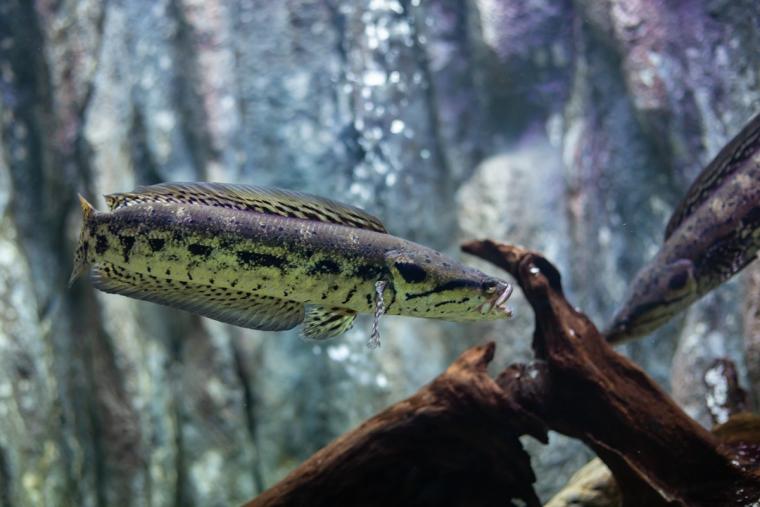
Snakehead are one of the invasive species that Maryland has targeted.
Officials in Maryland, Arkansas, Washington and other states have placed bounties on invasive fish species. Of course, fighting the likes of carp, catfish and other fish that crowd out local species is an annual battle. But this year, the stakes seem to be higher.
That’s why a new program in Baltimore, set to launch in April seeks to incentivize sustainable fishing in the Middle Branch of the Patapsco River. The Reel Rewards Program is funded and will be executed by several multisyllabic government, nonprofit and local stakeholder entities: the National Oceanic and Atmospheric Administration, the South Baltimore Gateway Partnership, the Interdisciplinary Consortium for Applied Research in the Environment, Reimagine Middle Branch and the Middle Branch Resiliency Initiative. It will, according to the nonprofit Environmental Justice Journalism Initiative that launched the program, target northern snakehead, blue catfish and flathead catfish, while offering “local fishers an opportunity to take part in environmental conservation and research initiatives while receiving incentives for their work.”
The catch? “Upon successfully catching any of the designated invasive species, participants are asked to collect the fish heads and deliver them to drop-off points on specified days. In exchange, fishers will receive $30 per invasive fish head submitted.”
Similarly, the Northern Pikeminnow Sport-Reward Fishery Program — funded by the Bonneville Power Administration in Portland, Ore., administered by the Pacific States Marine Fisheries Commission and implemented by the Washington Department of Fish and Wildlife — will pay anglers for each 9-inch or longer northern pikeminnow they catch within program boundaries on the Columbia and Snake rivers this spring and summer. Rewards begin at $6 per fish for the first 25 northern pikeminnow and climb to $10 per fish caught in greater numbers. Specially tagged northern pikeminnow net $500 each.
Between 2011 and 2020, the program’s top 20 anglers caught an average of 3,353 fish each and averaged reward payments of $27,836 each for the five-month season.
Meanwhile, the Arkansas Game and Fish Commission oversees the Invasive Carp Harvest Incentive Program, which offers anglers and businesses a subsidy of 18 cents per pound for invasive carp harvested and sold to offset low market prices. It also offers access to start-up fishing supplies and works with businesses to identify and address factors that limit the ability to capture as many invasive carp as possible.
Invasive carp “threaten the sustainability of our important recreational and commercial fisheries,” Matt Horton, the commission’s aquatic nuisance species program coordinator, said in a video about the program. “We recognize that controlling invasive carp is not something that our agency can do alone.”
So how did we get to this point?
The Arkansas Game and Fish Commission tells a story to which local officials in many regions of the country fighting the spread of invasive fish can no doubt relate to:

Invasive carp native to Southeast Asia, specifically silver carp, bighead carp, grass carp and black carp, were introduced into the U.S. in the 1960s, 70s and 80s to help control nuisance algae, aquatic plants and snails. Unfortunately, escape from aquaculture facilities and stocked waters during floods, and through intentional releases, resulted in their rapid spread throughout the Mississippi River Basin. Invasive carp continue to increase their range and abundance in many of our state’s major river systems, and threaten to destabilize ecosystems by competing with native aquatic species for food and disturbing critical habitats. Additionally, silver carp can create a hazard to boaters due to their jumping behavior when startled.
But fish aren’t the only invasive species plaguing recreational areas this year. The Old Indian Trail — an otherwise busy trail inside Michigan’s Sleeping Bear Dunes National Lakeshore — and the surrounding areas will be closed this summer because of an infestation of invasive hemlock wooly adelgrid, which National Park Service officials say can kill hemlock trees in as little as four years. The insects access tree nutrients at the base of the needles, starving the trees. In the fall and winter, the adelgids cover themselves with a white, waxy coating for protection that appears as wool bundles the size of a pinhead at the base of hemlock needles.
The infestation prompted the closure to slow the spread and allow for treatment; plans call for reopening the trail by this fall.

